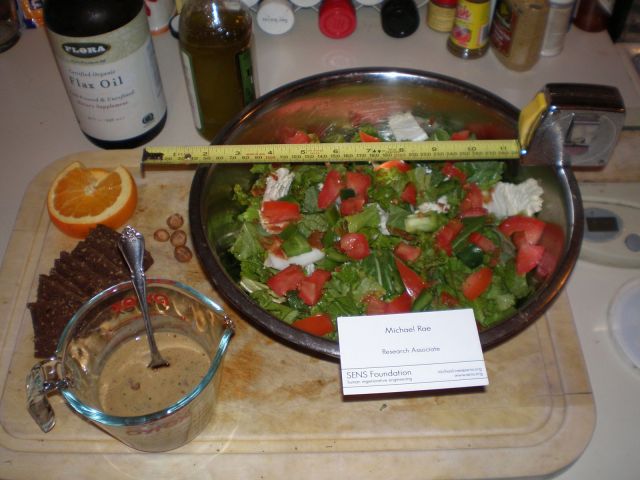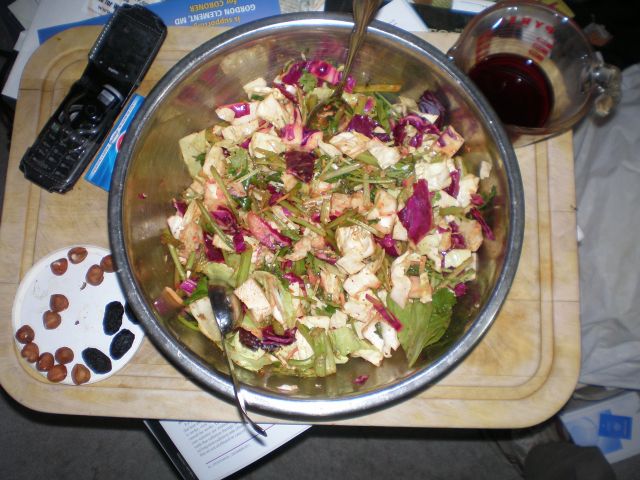After a long delay ...
As background, see my guidelines for starting CR (and this clarification of those guidelines); my guidelines on protein intake on CR; this post with a review and update (Nov 01 2014) of the DHA-accelerated aging hypothesis for my guidelines on intake of unsaturated fats; and reasons to think that saturated fat really is bad for you (followed by additional evidence on saturated fat).
In addition to moderating protein intake, I also moderate my intake of and of BCAAs, particularlyleucine (see this and this for more recent studies on health effects of high intake of leucine; we were discussing this study and this one). Note that while methionine post is heavy on emphasizing the impracticability of methionine restriction in humans, methionine moderation is justified practice. (Please, please, please, people, stop muddying the water by referring to limiting one's intake of some nutrient to RDAish levels as "restriction" of that nutrient! Biogerontological studies of protein, Met + Cys, Leu, Trp, or Calorie restriction involve restricting consumption of these nutrients to levels far below the animals' "RDA" intake; I don't practice or endorse that, and neither does anyone I know of (including a few folks who do, unfortunately, refer to what they do as "restriction" of that nutrient)).
You can selectively reduce your Met+Cys out crazy micro-management of protein sources if you minimize meat, dairy, and especially eggs, and focus on plant-derived protein other than grains (and particularly rice), preferably consuming said protein in its original matrix rather than as powders.
Beyond that, I also make sure to incorporate specific foods that have been documented in long-term, well-designed prospective epidemiological studies or clinical trials to reduce the risk or improve the outcomes in actual diseases or mortality: short-term results using unvalidated surrogate markers don't count at all, and even results with well-validated disease risk factors (glycemia, blood lipoproteins, etc) must be treated with some caution and do not meet this bar when taken in isolation. On the list: raw vegetables; leafy greens; cruciferous vegetables (broccoli, cauliflower, mustard greens, cabbage, etc); Allium vegetables (onions, garlic, etc); carrots; green vegetables; citrus (including the peel -- but eat organic and wash thoroughly); cooked tomatoes; nuts; green tea; coffee [added fall 2012]; moderate (3-10 oz/d) wine, taken with a meal.
Another food that is definitely on my "must-consume" list is real extra-virgin olive oil (outright fraud is rampant in the olive oil industry -- I have a zillion other links on this, and the author now has a whole book). The official chemical standards for extra-virgin olive oil per the International Olive Association (similar to the USDA and identical to the North American Olive Oil Association (NAOOA) (significance of each explained here and here), but this is a very low bar aesthetically and for your health based on what is achievable with modern miling methods. I insist on verifiably superior EVOO qualities: high (≥76%) oleic acid content (for oxidative stability, and see above on DHA-accelerated aging hypothesis: olives from different cultivars and regions can vary from 55-83% oleic acid); low peroxide value (<9, and preferably <6 meq/kg), and high (≥350 mg/kg) total phenolics, assayed using caffeic acid equivalents. Here, for instance, is a collection of studies on the benefits of high- (vs low-) phenolic olive oil. I recognize that I cannot point to the kind of really strong evidence for insisting on these qualities in EVOO that I can for olive oil full stop -- but I find the effects on surrogate markers in shorter-term clinical trials convincing, and I'm consuming EVOO anyway on the basis of strong evidence, and want to get the best.
An oil can be perfectly pure and of very high quality, but still have low oleic acid or phenolic content for reasons of cultivar, agronomy, or processing decisions, so you really have to work with a supplier who actually analyzes these things and is willing to be transparent with the results. (Recommended olive oil sourcing appended at the end of this post. I greatly respect the family behind this business because of the integrity of what they've worked to do, and have become quite friendly with a couple of them, but am in no way financially involved with the company).
High-cocoa, undutched chocolate (or defatted cocoa products, as in Binging Brownies (scroll down for the recipe; also note that this is a "sometimes food") would be on the list, were it not for worries about Parkinson's disease and heavy metals from chocolate (the dead-link news story on Goldman's study is here). Unfortunately, the study was greatly underpowered, and so was never submitted for formal publication; and while Dr. Goldman initially expressed interest in following up his preliminary result in a larger twin study, but has been unable to secure the funding to do so.
While it's not food, here is my 2017 supplement regimen 2012 supplement regimen. I've changed a few things even since then, but the strategy still applies.
What I Eat
Breakfast
Pomegranate juice + Diet Dr. Bob (generic "Dr. Pepper") Green tea w/prebreakfast pills, at least 1 h before breakfast (typically more like 100 mins, with another round of pills + green tea intervening).Nixed the pom juice out of concern about starting my day off with a big blast of sucrose — fall 2012..
Kefir cappuccino ‘shake’ made with nonfat kefir (listed as milk in record) and instant coffee grounds mixed directly into the shake; used as a dip for MegaMuffin.
Salad, composed of all other ingredients except orange; lettuces are a bagged mix; napa is actually raw.
Orange on side
60% (~142 Cals) of a MegaMuffin: this originates with CR practitioner Michael Sherman, based on the fact that rodent chow is one food that contains the full nutritional requirements for rodents in one food. The MegaMuffin aims to be "human chow," containing roughly 100% of the RDA for all essential nutrients per 1000 Calories. My latest recipe (Version 4.0), along with notes correcting the "recipe," is here, with baking instructions from an older version that includes important tips for all versions at the top of the thread; the whole thread can be read profitably.
Photo of breakfast:

Lunch
One of several 500 Calorie stews, composed of legumes, cruciferous vegetables, hazelnuts, EVOO, and spices; examples attached, with spices below. Recipes make 6 servings.
Remainder (~99 Cal) of MegaMuffin
Ultra Low-Protein Chili
3 T cilantro flakes
65 g fresh cilantro
1 T Cumin
2 T chili powder
2 tsp black pepper
6 cloves fresh or jarred ground or minced garlic (in COM)
2 T Brewer's Yeast (included in COM)
Salt (12 shakes ~900 mg from my shaker; this varies wildly from one to another)
1 T Bernard Jensen Seasoning
Lentil Curry
6 cloves fresh or jarred ground or minced garlic (in COM)
2.5 T Brewer's Yeast (included in COM)
1.5 T onion flakes
1 T cinnamon powder
4 T curry powder
1 T turmeric powder
Salt (12 shakes ~900 mg from my shaker; this varies wildly from one to another)
1 T Bernard Jensen Seasoning
Dinner
This varies quite a bit: I am blessed that April cooks me dinner >87% of the time, and in addition to being a culinary Goddess and willing to put up with my insanely anal dietary parameters, she's also an inventive and instinctive cook, so I very rarely eat the same thing twice (except when I cook for myself). My dinners are currently 600 Calories, 10-15% protein, ≤36% carb, ≤40% fat, and ~10% alcohol (3 oz red wine),always includes a teaspoon of flax oil, and usually includes ~2 tsp of EVOO, plus some hazelnuts, dried cured Peruvian olives -- and a lot of vegetables! For some example recipes, you can browse April's CR blog and/or try this search (which will get you a mix of dinners for me, food for her, and occasional scientific-ish Q&As; unfortunately, her blog software lacks a tagging feature for eg. 'recipes'). A few photos:

Curried Pumpkin Portabello Pizzas with Side of Veggies

Cool Dinner for a Hot Summer's Night
Red Cabbage, Romaine, Mustard Green Stems, Etc, Spiced with Quorn for protein

Pasta-Less Vegetarian Lasagna
Quorn grounds; cauliflower and zucchini instead of pasta; low- and nonfat dairy; lots of EVOO and Olives. 13" x 13" pan.
Between meals, I also over the course of the day drink 2 1.25 L of green tea and 4 C of coffee (1 C caffeinated, 1 C half-caf, 2 C decaf) [beverages switched in fall 2012], sweetened with sucralose or aspartame.*
Representative 2-week crunch on CRON-O-Meter:
General
===========================================
Energy | 1731.4 kcal 271%
Protein | 79.3 95 g [Protein bumped up in early 2012 after lab tests showed IGF-1 too low]
Carbs | 188.2 g 63%
Fiber | 67.3 g 224%
Starch | 2.2 g
Sugars | 59.1 g
Fat | 84.0 78 g (Compensating for increased protein)
Alcohol | 9.3 g
Caffeine | 400 mg (includes coffee)
Water | 1879.8 g 125%
Ash | 21.1 g
Vitamins (86%)
===========================================
Vitamin A | 31538.5 IU 1051%
Retinol | 105.2 µg
Alpha-carotene | 1444.6 µg
Beta-carotene | 17592.6 µg
Beta-cryptoxanthin | 23.5 µg
Lycopene | 12416.8 µg
Lutein+Zeaxanthin | 25686.3 µg
Folate | 1164.0 µg 233%
B1 (Thiamine) | 2.7 mg 227%
B2 (Riboflavin) | 2.5 mg 195%
B3 (Niacin) | 26.5 mg 166%
B5 (Pantothenic Acid)| 12.0 mg 240%
B6 (Pyridoxine) | 3.8 mg 224%
B12 (Cyanocobalamin) | 1.3 µg 55%
Vitamin C | 558.1 mg 620%
Vitamin D | 65.4 IU 16%
Vitamin E | 27.2 mg 181%
Beta Tocopherol | 0.2 mg
Delta Tocopherol | 0.0 mg
Gamma Tocopherol | 5.8 mg
Vitamin K | 1256.1 µg 1047%
Biotin | 0.0 µg 0%
Choline | 248.4 mg 45%
Minerals (100%)
===========================================
Calcium | 1214.6 mg 121%
Chromium | 0.0 µg 0%
Copper | 3.4 mg 377%
Fluoride | 92.6 µg
Iron | 21.8 mg 273%
Magnesium | 659.5 mg 157%
Manganese | 11.0 mg 480%
Phosphorus | 1700.8 mg 243%
Potassium | 6508.3 mg 138%
Selenium | 66.9 µg 122%
Sodium | 1235.1 mg 95%
Zinc | 14.5 mg 132%
Amino Acids (93%)
===========================================
ALA | 3.2 g
ARG | 4.9 g
ASP | 6.8 g
CYS | 1.0 g 70%
GLU | 11.5 g
GLY | 2.6 g
HIS | 1.6 g 151%
HYP | 0.0 g
ILE | 2.8 g 194%
LEU | 4.5 g 140%
LYS | 3.7 g 125%
MET | 1.1 g 74%
PHE | 3.0 g 117%
PRO | 3.1 g
SER | 3.1 g
THR | 2.5 g 165%
TRP | 0.8 g 220%
TYR | 2.1 g 85%
VAL | 3.4 g 1116%
Lipids (55%)
===========================================
Saturated | 9.9 g
Monounsaturated | 50.8 g
Polyunsaturated | 17.3 g
Omega-3 | 4.8 g 121%
Omega-6 | 12.5 g
Trans-Fats | 0.0 g
Cholesterol | 27.0 mg 9%
Phytosterol | 199.5 mg
Ultra-Premium EVOO Sourcing
I strongly endorse the fine folks who run Veronica Foods/Delizia Olive Oil, whose oils you can get through any of the client stores listed with the "VF" tag in EVOO author Tom Mueller's database of producers and sources of premium extra-virgin olive oil. These people are absolutely passionate olive oil fanatics -- and I know, because I've been geeking out with them on and off on the subject since June, 2010. Part of what they do to make sure they have some of the best damned EVOO on the planet is the obvious: they have intimate familiarity with their sources' operation, and own several of the farms and presses where the oils are made; AND they have the oils tested at reputable labs, including not only the basic IOC stuff, but novel quality tests introduced in Germany and Australia (diacylglycerol (DAG) ratio and pyropheophytin A), as well as concentration of phenolics and oleic acid content. (Indeed, it was the hereditary owner of the company, the eponymous Veronica Bradley, who first alerted me to the huge variation in oleic content in olive oils).
(One thing you do have to bear in mind when looking at their phenolic numbers: their poly counts are done at a lab that reports their results in tyrosol-equivalents, which tends to exaggerate the level of phenolics in a given oil compared to the more commonly-used caffeic or gallic-acid equivalents. This isn't intended to be deceptive -- it's like when you say you're whizzing down Main street at 55, but you mean in km/h when the benighted locals are used to mph, which makes a big difference! -- but you do have to bear it in mind. And unfortunately, while there is a definite conversion to go from metric to Imperial, poly measurement units' exaggeration of TOTAL polys varies, because of the differing SPECIFIC MIX of polys present in different oils, and variable experimental conditions for doing spectrophotometry from one lab to the next. As a rule of thumb, you can assume that the 'apples-to-apples' poly level of oils reported in tyrosol-equivalents, compared to most scientific studies or CoAs you'll see, is ~20% lower. I am pleased to say that as of summer 2013, VF are reporting their phenolic counts in caffeic acid-equivalents).
In addition to all of the above, a feature of their business model that is AFAIK unique is that they have global sourcing, and order in oil from both hemispheres all year round, so that they can always offer oil that is no more than 6-8 mo old: they bring fresh oils in from the S hemisphere in the (northern hemisphere) summer, and from the N hemisphere in the (northern hemisphere) winter, with a few oddball locations' oils turning up in between. Freshness is important in olive oil: studies show that EVOO with typical chemistry will no longer meet EVOO standards by the end of the year, due to oxidative and other degradation, and the phenolics, squalene, vitamin E, carotenoids, etc).
Artificial Sweeteners Note
* No, I am not worried about aspartame or sucralose. Indeed, the recent, much-hyped reportof increased cancer in aspartame-dosed rodents actually made me less nervous about aspartame: it (a) really didn't clearly show any increased cancer risk (they hyped up non-statistically-significant elevations in incidence of some cancers late in life, but also NS decreases in others), and indeed (b) reported identical survival curves between aspartame-treated and untreated animals (if anything, it looked like females given the highest dose lived LONGER on average than untreated animals); plus, there was massive mortality from inflammatory lung disease and other causes, showing that these people just can't raise healthy mice. Additionally, because aspartame has been on the market for a quarter century and is widely and selectively used, there's now been enough time for both additional direct human and animal research and decades of prospective epidemiology (eg. (1,2)) showing no ill effects over a wide range of intakes in humans. If you were alarmed by a recent scary-sounding paper in an otherwise-respectable journal,(4) please see this post showing that Humphries et al, "Abstract Direct and indirect cellular effects of aspartame on the brain," is junk science. However, I am beginning to become concerned about the emerging evidence suggesting long-term dysregulation of glucoregulatory hormones and signaling related to artificial sweetener use, and have cut back quite substantially on consumption of soda and sweetening tea and coffee. This change dates to fall 2012, and I became yet more aggressive in spring of 2013 in response to this study, which gives the most plausible biological mechanism for what had previously seemed very plausibly to be an artifact of correlation.
To read a thoughtful, non-paranoid, non-"it's-just-not-natural!" counterargument by a reputable and careful scientist, I refer you to Devra Davis' excellent (and disturbing) Secret History of the War on Cancer.
1. Soffritti M, Belpoggi F, Degli Esposti D, Lambertini L, Tibaldi E, Rigano A. First experimental demonstration of the multipotential carcinogenic effects of aspartame administered in the feed to Sprague-Dawley rats]. Environ Health Perspect. 2006 Mar;114(3):379-85. PMID: 16507461 [PubMed - indexed for MEDLINE]
2. Gallus S, Scotti L, Negri E, Talamini R, Franceschi S, Montella M, Giacosa A, Dal Maso L, La Vecchia C. Artificial sweeteners and cancer risk in a network of case-control studies. Ann Oncol. 2007 Jan;18(1):40-4. Epub 2006 Oct 16. PMID: 17043096 [PubMed - indexed for MEDLINE]
3. Lim U, Subar AF, Mouw T, Hartge P, Morton LM, Stolzenberg-Solomon R, Campbell D, Hollenbeck AR, Schatzkin A. Consumption of aspartame-containing beverages and incidence of hematopoietic and brain malignancies. Cancer Epidemiol Biomarkers Prev. 2006 Sep;15(9):1654-9. PMID: 16985027 [PubMed - indexed for MEDLINE]
4. Humphries P, Pretorius E, Naudé H. Abstract Direct and indirect cellular effects of aspartame on the brain. Eur J Clin Nutr. 2008 Apr;62(4):451-62. Epub 2007 Aug 8. [url=http://www.nature.com/ejcn/journal/v62/n4/pdf/1602866a.pdf]PMID: 17684524 [PubMed - in process]
Attached Files
Edited by Michael, 03 November 2018 - 03:39 AM.
fixing broken and expired links




















































